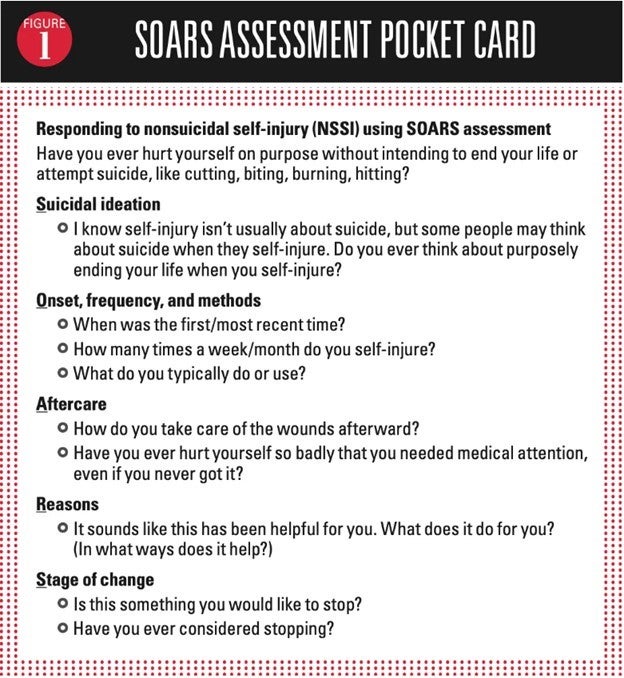Non-Suicidal Self Injury: Screening and Intervention

Introduction
Self-harm is a rising concern with adolescents. Non-suicidal self-injury (NSSI) refers to self-harm without suicidal intent (1). Studies show that 1 in 5 people will experience NSSI in their lifetime, with the highest prevalence being in adolescence (2). Signs can include always wearing long sleeves even in hot weather or having scars that seem unusual or unexplained. Early intervention can help improve outcomes for these patients, thus screening for NSSI in the primary care setting is recommended.
Numerous screening tools can be used to assess NSSI. The SOARS model (see figure 1) is a brief screening and assessment of NSSI that has been developed to use with adolescent patients. Additional screening tools are linked in the resources below.
If a patient is positive for NSSI, there are evidenced-based interventions that can be helpful, such as cognitive behavioral therapy and dialectical behavioral therapy. If you need help connecting your patient to treatment, please call one of Illinois DocAssist social workers today to help locate vetted resources in your area. In addition, the crisis text line number and website can be provided, which has useful tips to help deter a teen from self-harm (see below for more information).
Figure 1: The SOARS model for screening for NSSI

Figure 1: The SOARS model for screening for NSSI
Resources and References
Resources
Crisis Text Line: Text HOME to 741741 from anywhere in the United States, anytime. A live, trained volunteer Crisis Counselor receives the text and responds, all from our secure online platform. The volunteer Crisis Counselor will help you move from a hot moment to a cool calm. Their website has helpful tips for your patients on how to avoid self-harmful behaviors.
Child Mind Institute: Helpful article and resources related to cutting and other self-injury. “When kids intentionally hurt themselves, often by cutting or scratching their skin, as a way to manage difficult emotions.” Includes why kids may partake in these behaviors, the signs, and how parents can help.
Additional Screening tools for NSSI:
Some include the Non-Suicidal Self-Injury Assessment Tool (NSSI-AT), the Brief NSSI Self-Injury Interview (BNSSI); and the Self-Harm Inventory (SHI). However, these screeners have been mainly validated to use with adult populations and can be lengthy and harder to use in fast-paced clinical settings. A new screening tool called the Screen for Non-suicidal Self Injury (SNSI) shows promise for quickly identifying people with NSSI in doctor’s offices but has only been validated on adults at this time.
References
- Klonsky ED, Victor SE, Saffer BY. Nonsuicidal Self-Injury: What We Know, and What We Need to Know. 2014 Nov, 59(11):565-8. doi: 10.1177/070674371405901101. PMCID: PMC4244874.
- Wichstrom T and Wichstrom L. Childhood Predictors of Nonsuicidal Self-Injury in Adolescence: A Birth Cohort Study. Journal of the American Academy of Child & Adolescent Psychiatry. 2024 Feb; DOI: https://doi.org/10.1016/j.jaac.2023.12.013
- Halverson TF, Patel TA, Mann AJD, Evans MK, Gratz KL, Beckham JC, Calhoun PS, Kimbrel NA. The Screen for Nonsuicidal Self-Injury: Development and initial validation among veterans with psychiatric disorders. Suicide Life Threat Behav. 2022 Aug;52(4):615-630. doi: 10.1111/sltb.12847. Epub 2022 Mar 7. PMCID: PMC9378472.